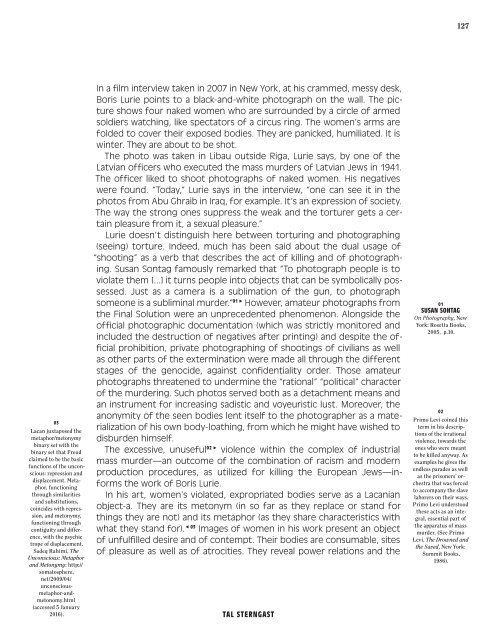The Art of
1WQggTh
1WQggTh
You also want an ePaper? Increase the reach of your titles
YUMPU automatically turns print PDFs into web optimized ePapers that Google loves.
127<br />
03<br />
Lacan juxtaposed the<br />
metaphor/metonymy<br />
binary set with the<br />
binary set that Freud<br />
claimed to be the basic<br />
functions <strong>of</strong> the unconscious:<br />
repression and<br />
displacement. Metaphor,<br />
functioning<br />
through similarities<br />
and substitutions,<br />
coincides with repression,<br />
and metonymy,<br />
functioning through<br />
contiguity and difference,<br />
with the psychic<br />
trope <strong>of</strong> displacement.<br />
Sadeq Rahimi, <strong>The</strong><br />
Unconscious: Metaphor<br />
and Metonymy: http://<br />
somatosphere.<br />
net/2009/04/<br />
unconsciousmetaphor-andmetonomy.html<br />
(accessed 5 January<br />
In a film interview taken in 2007 in New York, at his crammed, messy desk,<br />
Boris Lurie points to a black-and-white photograph on the wall. <strong>The</strong> picture<br />
shows four naked women who are surrounded by a circle <strong>of</strong> armed<br />
soldiers watching, like spectators <strong>of</strong> a circus ring. <strong>The</strong> women’s arms are<br />
folded to cover their exposed bodies. <strong>The</strong>y are panicked, humiliated. It is<br />
winter. <strong>The</strong>y are about to be shot.<br />
<strong>The</strong> photo was taken in Libau outside Riga, Lurie says, by one <strong>of</strong> the<br />
Latvian <strong>of</strong>ficers who executed the mass murders <strong>of</strong> Latvian Jews in 1941.<br />
<strong>The</strong> <strong>of</strong>ficer liked to shoot photographs <strong>of</strong> naked women. His negatives<br />
were found. “Today,” Lurie says in the interview, “one can see it in the<br />
photos from Abu Ghraib in Iraq, for example. It’s an expression <strong>of</strong> society.<br />
<strong>The</strong> way the strong ones suppress the weak and the torturer gets a certain<br />
pleasure from it, a sexual pleasure.”<br />
Lurie doesn’t distinguish here between torturing and photographing<br />
(seeing) torture. Indeed, much has been said about the dual usage <strong>of</strong><br />
“shooting” as a verb that describes the act <strong>of</strong> killing and <strong>of</strong> photographing.<br />
Susan Sontag famously remarked that “To photograph people is to<br />
violate them [...] it turns people into objects that can be symbolically possessed.<br />
Just as a camera is a sublimation <strong>of</strong> the gun, to photograph<br />
someone is a subliminal murder.” 01 However, amateur photographs from<br />
the Final Solution were an unprecedented phenomenon. Alongside the<br />
<strong>of</strong>ficial photographic documentation (which was strictly monitored and<br />
included the destruction <strong>of</strong> negatives after printing) and despite the <strong>of</strong>ficial<br />
prohibition, private photographing <strong>of</strong> shootings <strong>of</strong> civilians as well<br />
as other parts <strong>of</strong> the extermination were made all through the different<br />
stages <strong>of</strong> the genocide, against confidentiality order. Those amateur<br />
photographs threatened to undermine the “rational” “political” character<br />
<strong>of</strong> the murdering. Such photos served both as a detachment means and<br />
an instrument for increasing sadistic and voyeuristic lust. Moreover, the<br />
anonymity <strong>of</strong> the seen bodies lent itself to the photographer as a materialization<br />
<strong>of</strong> his own body-loathing, from which he might have wished to<br />
disburden himself.<br />
<strong>The</strong> excessive, unuseful 02 violence within the complex <strong>of</strong> industrial<br />
mass murder—an outcome <strong>of</strong> the combination <strong>of</strong> racism and modern<br />
production procedures, as utilized for killing the European Jews—informs<br />
the work <strong>of</strong> Boris Lurie.<br />
In his art, women’s violated, expropriated bodies serve as a Lacanian<br />
object-a. <strong>The</strong>y are its metonym (in so far as they replace or stand for<br />
things they are not) and its metaphor (as they share characteristics with<br />
what they stand for). 03 Images <strong>of</strong> women in his work present an object<br />
<strong>of</strong> unfulfilled desire and <strong>of</strong> contempt. <strong>The</strong>ir bodies are consumable, sites<br />
<strong>of</strong> pleasure as well as <strong>of</strong> atrocities. <strong>The</strong>y reveal power relations and the<br />
2016). TAL STERNGAST<br />
01<br />
SUSAN SONTAG<br />
On Photography, New<br />
York: Rosetta Books,<br />
2005, p.10.<br />
02<br />
Primo Levi coined this<br />
term in his descriptions<br />
<strong>of</strong> the irrational<br />
violence, towards the<br />
ones who were meant<br />
to be killed anyway. As<br />
examples he gives the<br />
endless parades as well<br />
as the prisoners’ orchestra<br />
that was forced<br />
to accompany the slave<br />
laborers on their ways.<br />
Primo Levi understood<br />
these acts as an integral,<br />
essential part <strong>of</strong><br />
the apparatus <strong>of</strong> mass<br />
murder. (See Primo<br />
Levi, <strong>The</strong> Drowned and<br />
the Saved, New York:<br />
Summit Books,<br />
1986).


